The best varieties of spring garlic: choosing the appropriate type according to parameters
Garlic has been widely appreciated throughout time. It is known that it contains many vitamins and microelements, and also has an excellent antibacterial effect. It’s hard to imagine a garden without garlic beds, especially since there are so many different varieties today.
Let's look at what varieties of garlic exist and which ones produce the best harvest.
Large-fruited winter varieties of garlic
Garlic can be either bolted or non-shooting. Arrowling varieties have an arrow shoot in the center of the head. Their cloves are larger, usually there are from 6 to 14 of them in one bulb, they are located around the arrow. Non-shooting varieties do not have such an arrow; small denticles are arranged in a spiral.
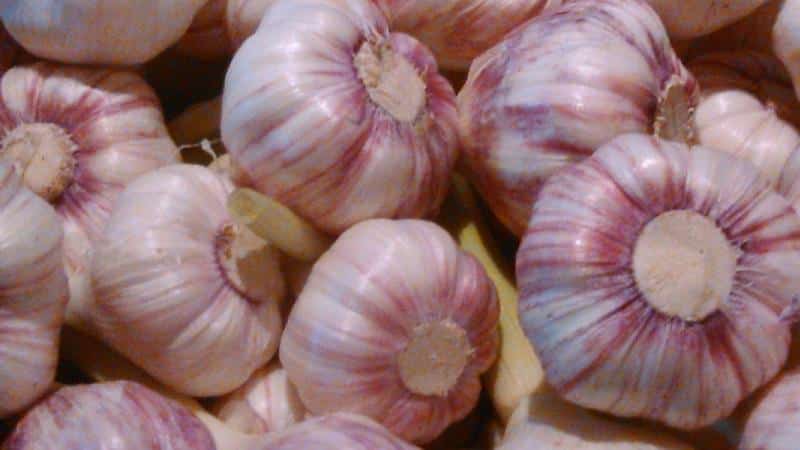
Non-shooters
Let's highlight the top 5 best non-shooting varieties:
- Odessky 13. The variety is early ripening. The heads have a flat-round shape, the average weight of one is from 15 to 28 g. Odessky 13 can be planted either in the winter, that is, a month before the start of frost, or in the spring - in mid-spring. Garlic scales are white with purple veins. As a rule, there are no more than 10 cloves in one head. Odessky 13 has a sharp spicy taste and good keeping quality: it can be stored without losing its taste and appearance.
- Moscow. Mid-season spring variety. Great for the Moscow region. Ripens within 99-105 days, reproduces only by teeth. The heads are dense, weighing about 14 g per head.The teeth are pointed, white, and there can be about 15 of them in one head. The Moscow variety has a mildly spicy, delicate taste, which is why they love to add it to dishes.
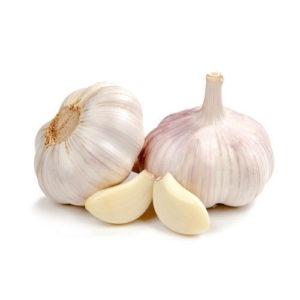 Saki. Belongs to early ripening varieties. The weight of one head is about 18 g. It stores well and is resistant to transportation. The winter hardiness of the variety is low, but it tolerates the lack of moisture well. The disadvantages include frequent damage by fusarium rot - this is a fungus that causes death and rotting of the roots. Saki garlic has a pungent taste, so the variety is perfect for pickling and canning.
Saki. Belongs to early ripening varieties. The weight of one head is about 18 g. It stores well and is resistant to transportation. The winter hardiness of the variety is low, but it tolerates the lack of moisture well. The disadvantages include frequent damage by fusarium rot - this is a fungus that causes death and rotting of the roots. Saki garlic has a pungent taste, so the variety is perfect for pickling and canning.- Broadleaf 220. Suitable only for fertile soil and warm climate. The weight of one head is from 80 to 100 g, the color is white with purple veins. Resistant to major diseases, but easily susceptible to onion fly. The taste is semi-sharp.
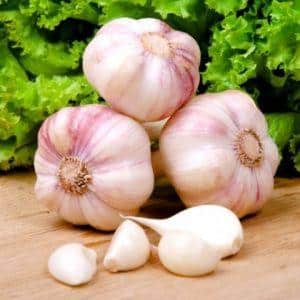 Gafuriysky. The snow-white heads weigh above average - about 40 g. The variety is resistant to rot, but is sometimes damaged by powdery mildew - this is a fungal disease in the form of a white coating. The variety has an attractive appearance (see photo), so it is often grown for sale. Gafurian garlic is also widely used in the preparation of spices and sauces: adjika, ketchup.
Gafuriysky. The snow-white heads weigh above average - about 40 g. The variety is resistant to rot, but is sometimes damaged by powdery mildew - this is a fungal disease in the form of a white coating. The variety has an attractive appearance (see photo), so it is often grown for sale. Gafurian garlic is also widely used in the preparation of spices and sauces: adjika, ketchup.
Shooters
The top 5 best shooting varieties include:
- Gribovsky anniversary. This variety appeared back in 1976. Belongs to medium-sized winter crops. It is best to plant it in the fall. The plant is heat-loving and gives a good harvest in open areas. It is highly resistant to viruses and fungal diseases, as well as temperature changes, and is well stored. The color of the scales is reddish, with a purple tint.
- Large-toothed Kiseleva. A winter crop, it is best to plant the variety in late September-early October. Does not require special care. Early ripening with large heads. The taste is spicy but pleasant. The bulbs are white, round and regular in shape. One contains about 5 cloves.
- Hermann. Garlic with a complex clove structure. The head is cone-shaped, cream-colored. One onion contains 6-8 cloves. Maintenance includes timely watering, loosening the soil and removing weeds. Can be stored for up to 8 months without loss of taste and vitamins. Resistant to bacterial infections.
- Scythian. Suitable for cultivation in any region of the country, it was bred back in 1993. The cloves are moderately sharp, so garlic is widely used in the preparation of salads, soups, and side dishes. Skif should be planted in open, bright spaces. The harvest is good both in the southern regions of the country and in the regions of central Russia.
- Gribovsky 60. The cloves have a purple tint; one head contains an average of 8-9 pieces. The shooting variety easily adapts to any weather conditions. Has an average shelf life. Undamaged by common bacteria and viruses.
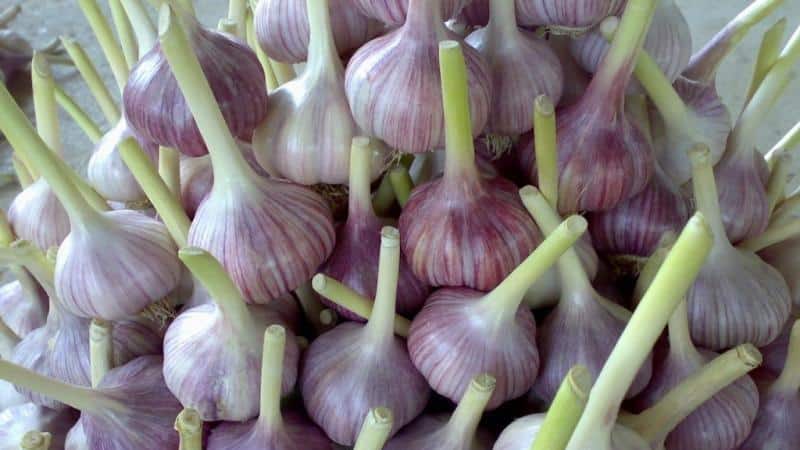
It will be interesting:
How to recognize spring and winter garlic
The most popular varieties
It is difficult to imagine a garden without garlic beds. This is not surprising, because the plant has a lot of useful qualities. Let's consider what The most popular varieties of this crop are:
- Saved. It features consistently high yields. The heads are oval in shape, one has about 8 cloves. The variety is mid-season, ripens within 110 days. It is better to grow it in open ground. It has become widespread not only in Russia, but also in neighboring countries.Spas is also resistant to the main enemy of crops - fusarium. The plant is universal in use: it can be consumed both fresh and after processing. Garlic contains ascorbic acid, essential oils, and vitamin B.
- Bashkirsky 85. Bulbs should be planted before frost sets in. The variety is resistant to bad weather, so it is perfect for planting in the Central and northern regions of the country. Do not forget to water the garlic in a timely manner and remove weeds. Since the variety is shooty, it is best to remove shoots that are too long. Bashkirsky 85 also needs a large amount of light. The plant is unpretentious and productive.
- Dubkovsky. Another representative of productive and unpretentious varieties. It is actively used by housewives for winter preparations. The heads are round, purple-cream in color. The presence of nitrogen fertilizers has a beneficial effect on productivity. Harvesting can be done either manually or mechanically.
- Bogatyr. A winter variety with many advantages: high shelf life, frost resistance, productivity. Winter shooter Bogatyr has large bulbs. The weight of one can reach 85 g. For planting, gardeners advise taking only large bulbs. The harvest should be stored in a dry, dark place - this way the garlic will retain its beneficial properties longer. The best predecessors for the variety are cabbage, potatoes, and cucumbers.
- Doctor. Winter non-shooting variety. Designed for marinating, salting, and sausage production. Contains inulin, sugar, vitamin C. The medicine is resistant to frost and produces a stable harvest even in a changeable climate. Its amount will increase if you fertilize the plant with organic substances. The harvest should be harvested on time, without putting it off on the back burner.
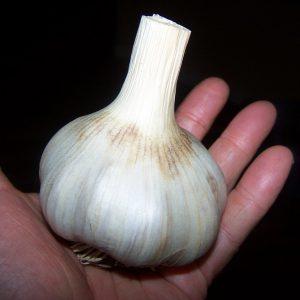 Rockambole. The largest garlic (its size can be estimated in the photo). Many people liked the huge heads of garlic. The variety is characterized by high taste and good keeping quality. Sometimes Rocambole is called garlic-flavored onion, since they are very similar in both taste and appearance. The first mentions of Rocambola date back to the 19th century. The crop needs regular weeding and loosening. It is grown on an industrial scale all over the world.
Rockambole. The largest garlic (its size can be estimated in the photo). Many people liked the huge heads of garlic. The variety is characterized by high taste and good keeping quality. Sometimes Rocambole is called garlic-flavored onion, since they are very similar in both taste and appearance. The first mentions of Rocambola date back to the 19th century. The crop needs regular weeding and loosening. It is grown on an industrial scale all over the world.- Komsomolets. It is best to plant the variety after legumes or potatoes. The culture loves large spaces and does not like shade. The variety also needs fertilizing - as a rule, gardeners use ammophoska. Full ripening of the fruit occurs 105-110 days after planting. It is best to dig up the plant on a dry, sunny day in the morning, and then spread it out on the garden bed to dry.
- Degtyarsky. It belongs to the varieties of spring garlic and has won the hearts of many gardeners. Resistant to drought and major diseases. It is grown both for personal use and for sale. Does not require special care; the taste is semi-sharp and piquant.
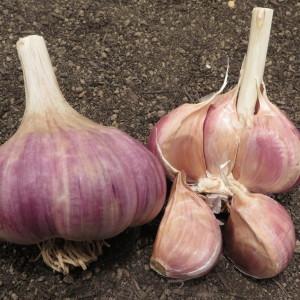 Kledor. This culture came to us from France. It does not tolerate weather changes and lack of moisture, so it is best to sow it at the end of April. Kledor belongs to the elite varieties, characterized by high taste. To get a rich harvest, you need to feed the plant with nitrogen fertilizers. Ash, chamomile or nettle infusion are excellent organic fertilizers. Fertilize the soil 2-3 weeks after the first shoots appear.
Kledor. This culture came to us from France. It does not tolerate weather changes and lack of moisture, so it is best to sow it at the end of April. Kledor belongs to the elite varieties, characterized by high taste. To get a rich harvest, you need to feed the plant with nitrogen fertilizers. Ash, chamomile or nettle infusion are excellent organic fertilizers. Fertilize the soil 2-3 weeks after the first shoots appear.- Permyak. The variety was created specifically for cultivation in harsh climatic conditions. The heads are medium in size, the taste is sharp.It does not require special care, the main thing is to water and fertilize the plant in a timely manner.
It will be interesting:
In addition to those listed, The following varieties have excellent taste:
- Flavor. A favorite variety in Holland, France, Spain, and Bulgaria. The variety is bolting, mid-season. The teeth are small and cream colored. The pulp is dense and juicy, with a moderately pungent taste. The main advantage is a long shelf life. The harvest is harvested at the end of August. As soon as you see yellow dry leaves, this is a sure sign that the vegetable is ripe.
- Sail. Garlic ripens 105 days after sowing. From 1 sq. m harvest about 1 kg of garlic. It is imperative to loosen the soil, otherwise the quality of the crop may deteriorate. Many gardeners alternate beds of garlic with beds of berries - this way the crop is less susceptible to disease and ripens faster.
- Sofievsky. Tolerates drought conditions well. Because of this, the plant is grown in areas with variable climates. The taste of the vegetable is medium-spicy, the heads are round in shape. One onion contains about 7 cloves.
- Alcor. This variety was bred in Siberia. Since garlic is winter, it is planted in the fall. Before planting, it is best to prepare the soil by adding organic fertilizers. In the future, it is necessary to water the beds in a timely manner and remove weeds. Alcor is widely used in cooking - as a seasoning for a spicy taste.
- Ershovsky. Mid-season non-shooting variety. One bulb can have up to 25 small cloves. It is resistant to weather changes, so it is recommended for planting in the northern regions of the country.
- Podmoskovny. Grows well throughout central Russia. The weight of the bulb is about 60 g.The plant is universal in use, well suited for pickling and canning.
- Dobrynya. This garlic is resistant to fusarium and a number of other common diseases. It has excellent taste. However, this variety has one significant drawback: Dobrynya is not able to be stored for a long time; after 4 months the vegetable begins to rot and dry out. Therefore, you should sort out the garlic from time to time and throw away spoiled heads.
- Lyubasha. Winter variety, average ripening time is approximately 90 days. Despite the fact that Lyubasha is resistant to temperature changes, it is best to cover the beds with film. In severe frosts, the variety may die. The taste is good, the flesh is juicy.
- Gulliver. This variety appeared in 2001. It is often confused with Rocambol, which causes a lot of conflicting reviews. The vegetable is rich in amino acids and vitamin C. The variety has an average shelf life of about 8 months.
- Victorio. The yellow-white bulbs are resistant to fungi and infections. Belongs to mid-season varieties, the harvest is good. The weight of one head is about 40 g.
- Elenovsky. The variety is relatively new. When spring planting, you need to plant the crop in early spring. As soon as the first shoots appear, you should feed the plant with fertilizers. This can be either organic fertilizer or chemical mixtures specially designed for this. You can purchase them at any garden supply store.
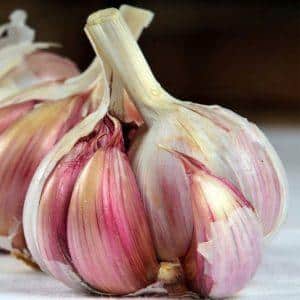 Aleysky. Excellent for the harsh conditions of Siberia. Universal to use. It is also often dried and used as a seasoning. It is easy to care for and resistant to bad weather.
Aleysky. Excellent for the harsh conditions of Siberia. Universal to use. It is also often dried and used as a seasoning. It is easy to care for and resistant to bad weather.- Abrek. Mid-season variety. The pulp is dense, the taste is sharp. From 1 sq. m you can harvest up to 1 kg of garlic, which indicates high yield.Abrek is stored for up to 7 months. The bulbs are round, the weight of one is about 30 g. The scales are dry, cream-colored. Like most varieties, it is universal in use.
Criterias of choice
First of all, pay attention to the following indicators:
- Adaptability to weather. There are varieties that produce rich harvests only in warm climates. Therefore, if you are a resident of the central zone or northern regions of Russia, it is best to pay attention to garlic intended specifically for your climate.
- Taste qualities. If you are a fan of spicy food, then you are unlikely to like garlic with a delicate, slightly spicy taste.
- Some varieties are unpretentious in care, while others require regular feeding and fertilizer. Please note that how much time and effort do you need to spend on growing.
- Head size. For winter preparations it is better to use large cloves, for spices - smaller cloves.
Important! Before you make your choice, ask your gardener friends which variety they prefer. People whose knowledge is based not only on theory, but also on practice, will tell you about the merits of this or that garlic.
Garlic for northern and southern regions
If you live in the northern regions of Russia, then pay attention to the following varieties:
- Scythian;
- Saved;
- Bashkirsky 85;
- Doctor;
- Permyak;
- Sofievsky;
- Alcor;
- Aleysky.
If you are a resident southern regions of Russia and Ukraine, we recommend you the following varieties:
- Saki;
- Kledor;
- Lyubasha;
- Broadleaf 220;
- Gribovsky anniversary.
Conclusion
Garlic is a storehouse of vitamins and essential oils. It is loved by gardeners all over the world. The crop is easy to care for; the main thing is to water the beds on time and remove weeds.From time to time you need to give the vegetable nitrogen-containing fertilizers.
There are many varieties to suit every taste: winter and spring, large and small, spicy and not very spicy. Before planting a particular variety, study its advantages and disadvantages.